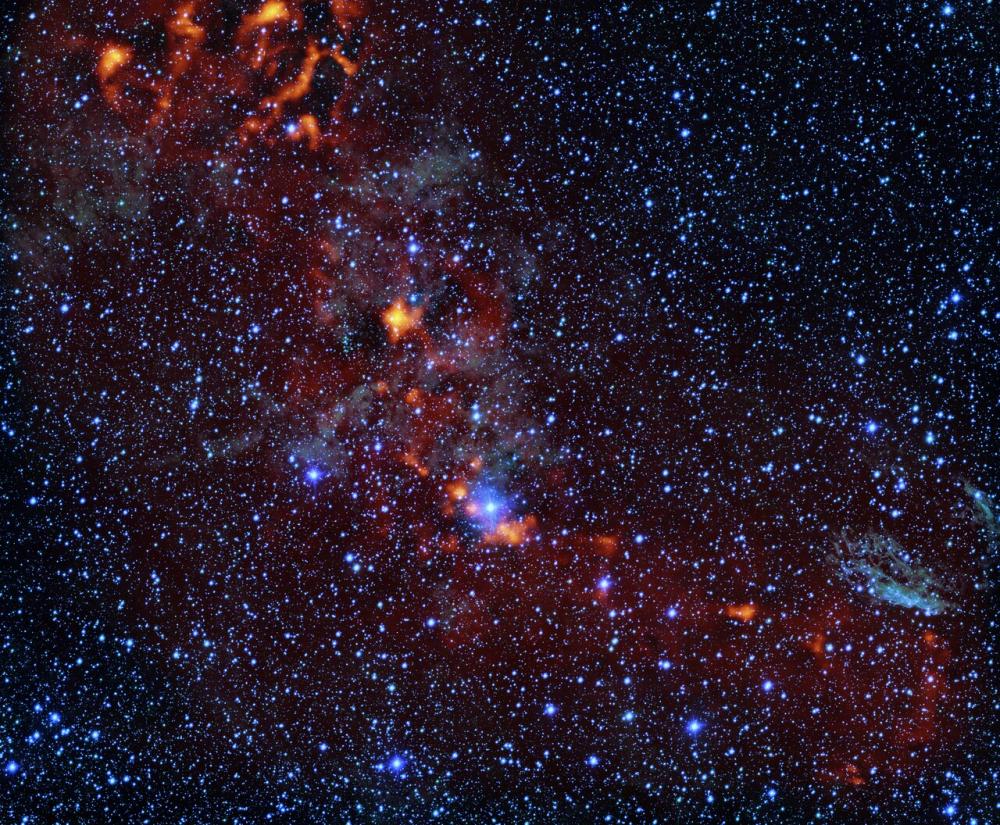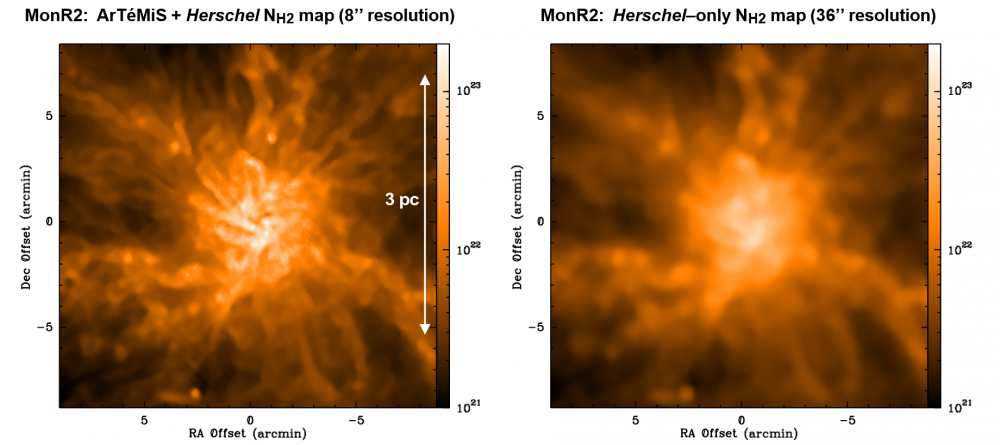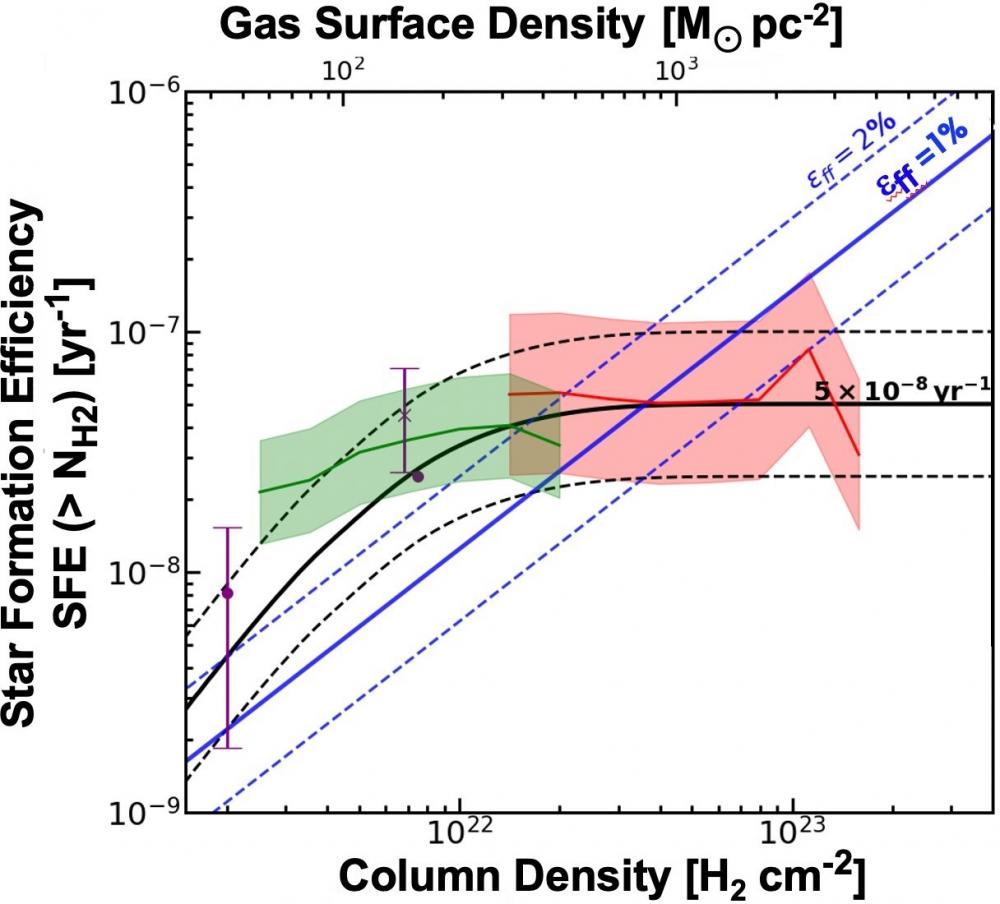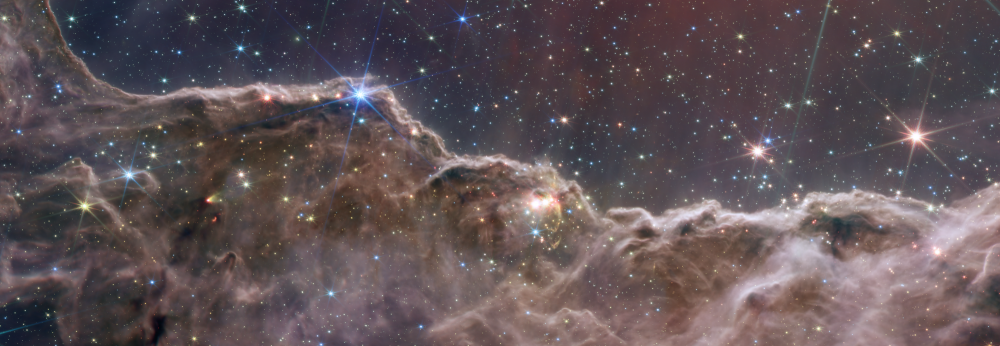
Figure 1: The glowing clouds visible in this ESO Picture of the Week image reveal regions of dense gas (in red) where new stars are being born in the RCW 106 region. Only 1% of this gas will turn into stars, a phenomenon whose inefficiency remains unexplained by astronomers. This image is the result of superimposing a dense gas map captured by APEX's ArTéMiS camera, and an optical image taken by the VLT Survey Telescope (VST).
Credit: ESO/M. Mattern et al. 2024
Understanding star formation remains one of astrophysics' great mysteries. Only 1% of the dense molecular gas in galaxies transforms into stars, a phenomenon that scientists are still striving to explain, despite some advancements. As part of the CAFFEINE project, a research team from CEA – Paris-Saclay utilized the ArTéMiS camera on the APEX telescope in Chile to map massive molecular clouds at an unprecedented resolution at submillimeter wavelengths. Their findings reveal that star formation efficiency does not depend on the density of molecular gas beyond a critical threshold. This may be due to the way these denser clouds fragment into filamentary structures and gas globules, from which stars eventually form. Future studies, including observations from the James Webb Telescope and the ALMA interferometer, promise to deepen this understanding.
This study has been featured as the ESO Picture of the Week, and the results are published in the journal Astronomy & Astrophysics.
The importance of studying dense molecular gas
Stars are fundamental building blocks of the Universe. Understanding the factors that govern their formation within the cold interstellar medium (molecular clouds) of galaxies is thus one of the key questions in astrophysics.
In 1970, the carbon monoxide (CO) molecule was discovered in the Orion molecular cloud. This molecule, the second most abundant in the universe, has a readily identifiable spectral signature, enabling the measurement of a molecular cloud's mass. Thanks to this discovery, astrophysicists were able to directly estimate the mass of molecular clouds in our galaxy, revealing that the star formation rate is closely tied to the amount of available molecular gas. It then became apparent that star formation is surprisingly inefficient, with only 1% of molecular gas being converted into stars. This low efficiency explains why our galaxy does not form stars at an excessive and unobserved rate. The origin of this inefficiency has remained a puzzle for astrophysicists for nearly fifty years.
Recent studies, including those using submillimeter wavelengths with the Herschel Space Observatory, have revealed that star formation primarily occurs within dense molecular gas, with negligible contribution from low-density gas. This suggests that the mass of dense gas is a far more crucial factor for star formation than the total amount of available molecular gas. Observations from Herschel have shown that most solar-type stars in the solar neighborhood (within about 500 parsecs) form within filaments of cold (around 10 K) and dense molecular gas, with a typical width of about 0.1 parsecs and a critical density of around 16 solar masses per parsec.
However, it is still unknown whether all filaments that exceed this critical density form stars with similar efficiency or whether their efficiency increases with density.
The resolution capability of the Herschel telescope was, however, insufficient to discern the filamentary structure of molecular gas beyond the solar neighborhood, in massive star-forming complexes of the Galactic Plane, located at distances well beyond 500 parsecs. These regions contain the majority of dense gas and are responsible for most of the star formation in the Milky Way.

Figure 2: Comparison of images of the MonR2 cluster-forming molecular cloud obtained as part of the CAFFEINE project with ArTéMiS and Herschel data (left panel) and with Herschel data alone (right panel). ArTéMiS data increase image resolution by a factor of 4. The CAFFEINE project provided high-resolution images of 49 massive star-forming galactic clouds.
Credit: M. Mattern et al. 2024

Figure 3: Star formation efficiency as a function of average density in the 49 clouds of the CAFFEINE survey (red line and pink error bars), compared with results obtained in lower-density clouds in the solar neighbourhood obtained with the Hershel telescope (dark green line and lighter error bars). The blue and black lines (with associated dotted errors) represent two competing theoretical models. The first one (in blue) predicts that star formation efficiency is regulated by turbulence and proportional to gas density, while the second one (in black), the “filament” model, suggests that star formation efficiency reaches saturation at a critical gas density. The CAFFEINE survey results favor the filament scenario.
Credit: M. Mattern et al. 2024
The CAFFEINE survey with ArTéMiS provides new insights into star formation
To investigate the relationship between star formation and the density of molecular clouds beyond our local neighborhood, a research team led by the Department of Astrophysics at IRFU, CEA – Paris-Saclay, utilized the ArTéMiS camera on the Atacama Pathfinder Experiment (APEX) telescope to observe 49 massive star-forming galactic clouds. This survey, named CAFFEINE, enabled imaging of all dense clouds up to a distance of 3 kpc with a resolution approximately four times better than that of Herschel (see Figure 2). These observations revealed that these molecular clouds contain two orders of magnitude more dense gas than those in the solar neighborhood, imposing much stricter constraints on the dependence of star formation efficiency on gas density within molecular clouds compared to what was possible with Herschel.
The results of this study show that star formation efficiency does not increase with cloud density, remaining roughly constant beyond the critical density of molecular filaments, which is about 16 solar masses per parsec (see Figure 3). Overall, the CAFFEINE study suggests that star formation is inefficient because it is regulated by the physical processes that govern the fragmentation of dense gas filaments into small-scale protostellar cores. Moreover, dense filaments constitute only a small fraction of the total mass of molecular clouds, which also greatly contributes to this inefficiency.
Future observations to go further
New observations with the James Webb Space Telescope (see Figure 4) and the large ALMA interferometer are currently underway to better understand how molecular filaments fragment and form protostars, a key stage in star formation within galaxies.
For a more comprehensive understanding of this process, it will be crucial to consider the influence of magnetic fields. To achieve this goal, a multi-wavelength polarimetric imager in space, such as the "B-BOP" instrument initially proposed for the SPICA project, would be invaluable. The research team therefore plans to upgrade the ArTéMiS focal plane in the coming years by integrating new B-BOP-type bolometric detector arrays, which are currently being developed at the Laboratory of Electronics and Information Technology (LETI) at CEA – Grenoble.

Figure 4: Composite image of the Carina Nebula, captured by the NIRCam and MIRI cameras on the James Webb Space Telescope. Ultraviolet light from young stars (above the image) in the nebula compresses dense molecular clouds, known as “Cosmic Cliffs”, to form new stars.
Credits: NASA, ESA, CSA, STScI
Contacts Irfu/Dap : Philippe ANDRÉ, Michael MATTERN, Vincent REVÉRET
Publication : "Understanding the star formation efficiency in dense gas: Initial results from the CAFFEINE survey with ArTéMiS" M. Mattern, Ph. André, A. Zavagno et al. 2024, Astronomy & Astrophysics (& ArXiv Link)
• Thèmes de recherche du Service d'astrophysique
• Institut de recherche sur les lois fondamentales de l'Univers (Irfu) • Le Département d'Astrophysique (DAp) // UMR AIM
• Laboratoire de Formation des Etoiles et du Milieu Interstellaire • Laboratoire Spectro-Imageurs pour le Spatial
• ArTéMiS


